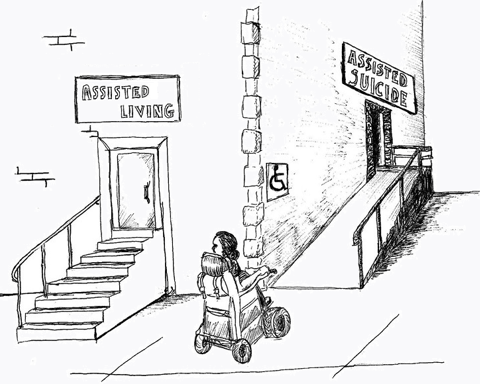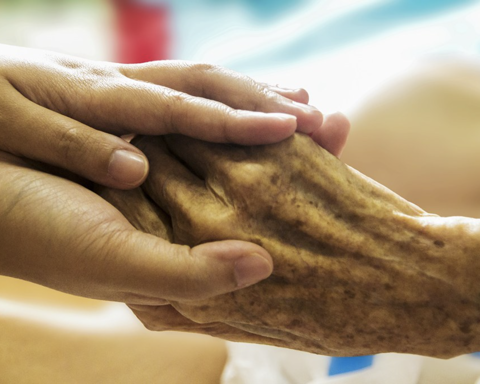Suicide Prevention: Does Legalising Assisted Suicide Make Things Better Or Worse? (Professor David Albert Jones)
Read in PDFPromoting euthanasia or assisted suicide (EAS) seems to contradict the principle that ‘every suicide is a tragedy’. It has also been argued that the normalisation of EAS might encourage non-assisted suicide. On the other hand, others argue that legalisation of EAS could help prevent suicide. This is because there are people with terminal illnesses who die by non-assisted suicide. If EAS were available they could die by EAS instead of non-assisted suicide, or perhaps the security of ‘knowing they had the option’ might help them live until their natural death.
Whether legalising EAS encourages suicide or helps prevent suicide is an empirical question. We need to look at the evidence. There have been several studies published on this topic in peer review journals in recent years.
These studies have found that, after EAS is introduced:
- Rates of EAS increase significantly
- Rates of self-initiated deaths (EAS plus non-assisted suicide) increase significantly
- The increase in self-initiated death is disproportionately high in women
- Rates of non-assisted suicide also increase, in some cases significantly
No study has found a reduction in non-assisted suicide relative to non-EAS states.
The available evidence all points in the same direction. Legalising euthanasia or assisted suicide does more harm than good, and is a threat to suicide prevention.
It is a fundamental principle of suicide prevention that ‘every suicide is a tragedy’. [1] Every death robs the world of someone who is unique, irreplaceable, a world in themselves. The painful truth is that every life that is given will at some point be taken away – everyone who is born will die. This is a natural necessity; it is something we must come to accept both in relation to ourselves and in relation to those we love. However, death by one’s own hand is a tragedy in a stronger sense. It is not a natural necessity. It is not something any non-human animal does and it is not something that is a necessary part of any human life. We have to accept death but we do not have to accept suicide. The situation may seem overwhelming but people can and often do find a way through, they can be supported, and suicide can be prevented.
Some of this paper concerns statistics, and statistics are important for helping weigh up the consequences of actions, especially the consequences of political actions such as changing the law.
However, statistics are abstractions and it must be kept in mind that every premature avoidable death by someone’s own hand is that of a person with a story, with loved ones, a life cut short.
It may be acknowledged that in different times and places there have been forms of suicide that are socially approved or even encouraged in certain circumstances. [2] Obvious examples would be honour suicide such as seppuku in Japan, grief suicide such as sati in India, protest suicide such as self-immolation during the Vietnam war, or mass religious suicide associated with certain cults in the United States. Such deaths show an individual’s commitment to an ideal that can perhaps be admired, but the cultures or subcultures that produce them create a harmful expectation that someone should take their own life. They produce a context in which it is regarded as shameful to continue to live.
It is dangerous to glorify or sensationalise self-inflicted death in this way. [3] This is not to criticise those who have died but to be critical of the way that such deaths are represented or encouraged. There is clear evidence that irresponsible media reporting of suicide can have a harmful effect. On the other hand, responsible reporting, and reporting of positive stories of people who have overcome challenges in life, can have a beneficial effect. [4]
Euthanasia and assisted suicide (EAS) involve the intentional ending of life of someone who desires that their life be ended. [5] Physician-assisted suicide is suicide using means provided by a physician for that purpose. Euthanasia is death at the hands of another, but it is a self-chosen death and as such may be considered a form of suicide. It might be called ‘suicide by doctor’ on the analogy to ‘suicide by cop’ [6] where someone deliberately acts with the aim of provoking police officers to use lethal force against them. The person plans that their life be ended by another.
It has been argued that EAS is categorically different from other forms of suicide and that ‘use of “suicide” in this context is not appropriate, given that the person will only be able to request an assisted death if they have a terminal illness that will end their life i.e. the choice to live has already been taken away’. [7] However, this is to forget that there are deaths by non-assisted suicide among people with a terminal illness or with a chronic incurable condition. We do not say of these deaths that that ‘the choice to live has already been taken way’. We recognise that they had more life to live, perhaps weeks or months, perhaps years. The imperative of suicide prevention rests on a recognition that every person matters and that this applies to people who are old or who live with terminal or incurable chronic illness, no less than it applies to those who are young and physically healthy.
EAS is also thought to be categorically different from other forms of suicide in that the death is chosen in advance in consultation with a physician. [8] In places where it is legal, death by EAS is also socially accepted and is typically, though not always, less traumatic for loved ones than death by other forms of suicide. Nevertheless, every death by EAS is one that occurs earlier than it might have done. It is not simply another end-of-life option. People are generally happy to encourage someone who is dying to consider options such as hospice care, but would rightly be concerned if they found that someone was actively being encouraged to consider EAS. [9]
EAS is often presented as an act of autonomy, but where people have a choice, the overwhelming majority ask a doctor to do it rather than self-administer the lethal dose. [10] They do not wish to do it themselves. Ambivalence about assisting suicide is present even in countries such as Switzerland, where the practice has been legal for decades, but where the rapid increase in deaths by assisted suicide, especially high among older women, is seen as a cause for concern. [11]
EAS is often presented as a rational act, excluding mental illness. [12] However, it is known that mental illnesses such as depression and anxiety are under-diagnosed in older people and in those with severe physical illness. [13] Research also shows that many of the factors that make people vulnerable to non-assisted suicide also make them vulnerable to EAS – lack of engagement with enjoyable activities, fear of losing independence and of not being able to remain at home, fear of being a burden to others. [14] While EAS is more socially approved than non-assisted suicide, EAS is a form of self-initiated death and it is possible to ask whether such a death might have been averted if the person had more support in living.
If EAS is acknowledged to be a form of suicide, albeit typically less violent or impulsive than many other forms of suicide, then the imperative to prevent suicide also applies to how cases of EAS are reported. [15] These deaths should not be presented as necessary or inevitable and should not be romanticised. Even where it is legal EAS should not be advertised or encouraged. Above all, it should not be stated or implied that there is shame attached to living with disability or illness or in receiving help and support. It must never be implied that human dignity can only be recovered by a self-initiated death.
Encouraging EAS would appear to be in direct contradiction to the imperative to prevent suicide. However, it has been argued that, as paradoxical as it may seem, legalisation of EAS could help prevent suicide. This is because, in countries where EAS is prohibited, there are people who have terminal illnesses and would be eligible for EAS if it were legal but who die by non-assisted suicide. Recent analysis of evidence by the Office for National Statistics has shown that patients in England ‘with some serious conditions are twice as likely as the general population to kill themselves’. [16]
Those who are in favour of a change in the law argue that these findings ‘illustrate the dangers of this country’s ban on assisted dying’. [17] These statistics confirm ‘what has been uncovered in other jurisdictions about the [negative] impact of the prohibition of assisted dying’. [18] This argument does not only relate to statistics but to concrete cases. Some bereaved relatives have argued that people who died by suicide after a diagnosis of a terminal illness might have died later, and more peacefully, had EAS been a legal option. [19]
It is not only that the person might have died by EAS instead of non-assisted suicide. It is argued that the security of knowing that EAS was an option would allow them to delay the decision and in many cases they would have gone on to die a natural death. Evidence shows that in all jurisdictions where EAS is legal, a high proportion of people who are approved for EAS do not in fact make use of it. [20] This may be because of ambivalence about the decision but it may be because ‘knowing they had the option gave them peace of mind to continue living’. [21] Hence it is argued that not only would the legal availability of EAS reduce non-assisted suicide but it may do so without increasing the overall number of self-initiated deaths (that is, deaths either by non-assisted suicide or by EAS).
This argument has been made explicitly and repeated by the two largest right-to-die organisations in Switzerland, Dignitas and EXIT:
[T]he option of an assisted/accompanied suicide without having to face the severe risks inherent in commonly-known suicide attempts is one of the best methods of preventing suicide attempts and suicide. It may sound paradoxical: in order to prevent suicide attempts, one needs to say ‘yes’ to suicide. [22]
EXIT’s option of physician-assisted suicide is actually an effective form of suicide prevention. Living in the certain knowledge of a way out has motivated more than half of the people originally intent on dying to keep enduring their painful lot until they passed away the natural way. [23]
This is a serious argument. It is based on the undeniable and neglected reality that people with terminal or incurable chronic illnesses have a greater vulnerability to non-assisted suicide, and it suggests that legalisation of EAS could help prevent these suicides. If the arguments of EXIT and Dignitas are sound, introducing EAS will not only reduce non-assisted suicide but will reduce the number of self-initiated deaths overall. The security of having the option might be enough for most people.
There are thus two contrasting views about how the legalisation of EAS could influence suicide rates:
- Some are concerned that making EAS legally available would encourage suicide: increasing the overall rate of self-initiated death (including EAS) and possibly also increasing the rate of non-assisted suicide;
- Others argue that legal availability of EAS would prevent some suicides: reducing the rate of non-assisted suicide and possibly also reducing the overall rate of self-initiated death.
The impact of legalisation of EAS on suicide prevention is an empirical question. It is possible to examine jurisdictions that have legalised EAS, or made EAS more widely available, and test whether this has had a harmful or a beneficial effect on non-assisted suicide and on overall self-initiated death.
In 2015, I looked into this together with a colleague who is a professor of economics. We examined non-assisted suicide rates and rates of physician-assisted suicide in the United States. This provided a natural laboratory, as it were, as relatively few states had legalised assisted suicide while most had not, and those which had legalised assisted suicide had done so at different times. The conclusion of this paper, published in the Southern Medical Journal (SMJ) was that:
Controlling for various socioeconomic factors, unobservable state and year effects, and state-specific linear trends, legalising PAS [physician-assisted suicide] was associated with a 6.3% increase in total suicides (including assisted suicides). This effect was larger in the individuals older than 65 years (14.5%).
The results pertaining to non-assisted suicide rates were equivocal. Some estimates suggested that PAS also was associated with a significant increase in the rate of non-assisted suicide. When we included state-specific trends, however, the estimated association, although positive, was smaller and no longer statistically significant. [24]
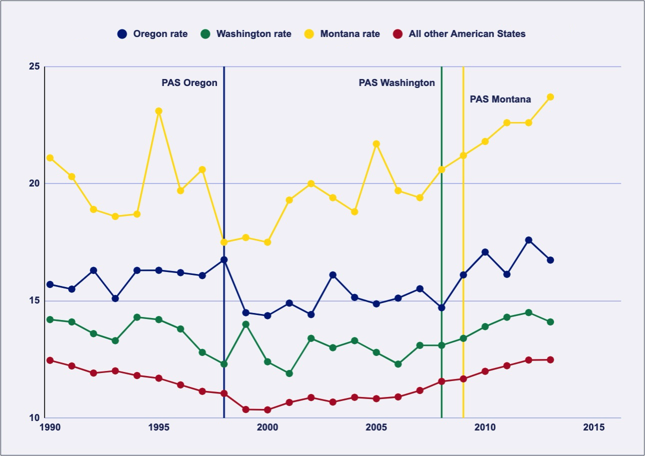
There was strong evidence that significantly more people took their lives and there was no evidence of reduction in non-assisted suicide. Note that these results concerned the model of EAS used in Oregon, physician-assisted suicide for people with a terminal illness, which is the model currently being proposed in Scotland and in England and Wales.
This finding was widely reported in the media. It also attracted some attention in peer review journals including a critical paper by Matthew Lowe and Jocelyn Downie in 2017 in the Journal of Ethics in Mental Health. [25] These authors pointed to other possible factors that could have been included in the SMJ paper, but they did not show that doing so would have changed the results.
Lowe and Downie also argued that, even if the results accurately reflected the situation in the United States, this would not demonstrate that the same would necessarily follow in other countries. A prima facie consideration of OECD (Organisation for Economic Cooperation and Development) data seemed to suggest that, in Europe, legalising assisted suicide or euthanasia was either neutral or was associated with a reduction in non-assisted suicide. Lowe and Downie’s paper was cited in a higher-profile article published in 2018 in the Canadian Journal of Psychiatry, which summarised their results as follows:
Lowe and Downie analysed OECD statistics for non-assisted suicide in Switzerland, Belgium, the Netherlands, and Luxembourg. They found that overall, suicide rates either stayed the same or decreased after MAID [medical assistance in dying] legislation… was passed in those jurisdictions. [26]
If this analysis is valid then the evidence from the United States and Europe would seem to point in opposite directions.
It is certainly true that ‘suicide trends in Oregon and Washington do not necessarily reflect or predict the effects of the legalisation of medical assistance in dying in other countries’. [27] However, the analysis of the OECD data by Lowe and Downie was cursory. It did not consider the dates when the EAS laws came into effect. It did not compare suicide rates in countries with EAS to rates in neighbouring European countries without EAS. It did not consider data on deaths by EAS and it did not consider rates of suicide for male and female separately (though the OECD provides data for male and female rates of suicide as well as the combined total).
This extra context is supplied in a paper published in 2022 in the same journal. [28] The 2022 paper compares Belgium to France, its most similar non-EAS neighbour. Since Belgium legalised EAS in 2002 the rate of non-assisted suicide has declined but not as much as France over the same period. Indeed, far from being a model for suicide prevention, Belgium currently has the highest OECD rate suicide in Western Europe. [29]
The country with the highest rate of EAS in Europe is the Netherlands. Its only non-EAS neighbour is Germany. EAS occurred in the Netherlands prior to the statute law passed in 2001 but the new law represented a further normalisation of the practice. After 2001 the rates of EAS were relatively flat but from 2007 began to rise very steeply. Over this period, the non-assisted suicide rate did not fall but also started to rise. This contrasts with Germany which has had flat or declining rates of non-assisted suicide since 2001.
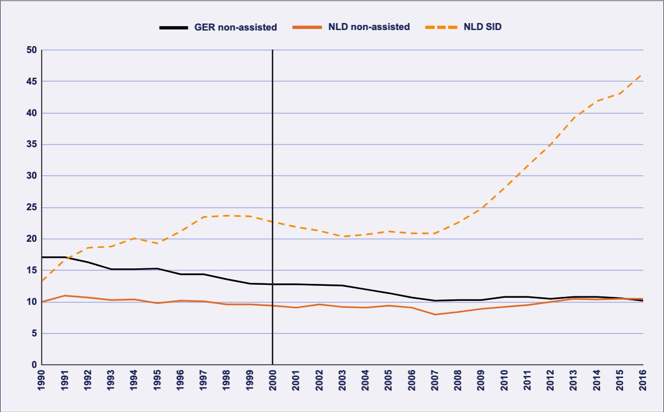
In Switzerland, assisted suicide has been legal since 1942. However, it only became an organised practice in the 1980s and it was not until 1998, the year that Dignitas was founded, that the government began to collect statistics. [30] From 1998, it is possible to calculate what the suicide rate is either with or without assisted suicide and to compare this with data from Austria which is its most similar non-EAS neighbour. When compared, non-assisted suicide in Switzerland is seen to decline at a similar rate to that in Austria, but since 1998 the rate of self-initiated death (non-assisted plus assisted suicide) flattens and then begins to rise. The pattern in women is even more dramatic. In women, the overall rate of self-initiated death in 2017 is almost twice what is was in 1998. [31]
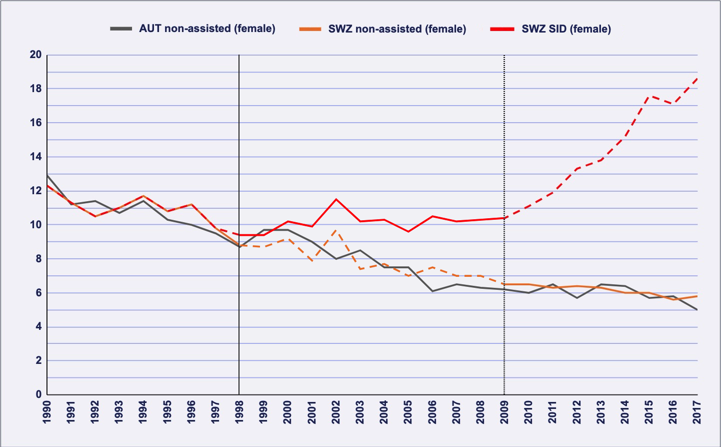
When the OECD data for Europe is placed in context, the pattern is similar to that discovered in the data from the United States. In comparison to neighbouring jurisdictions without EAS, states with EAS show clear evidence of increases in self-initiated death and some evidence of increases in non-assisted suicide. No jurisdiction shows a reduction in non-assisted suicide after the introduction of EAS relative to neighbouring non-EAS states.
In addition to studies that analyse the data from specific countries, it is possible to conduct a systematic literature review to consider all the evidence that has been published in peer review journals on this topic. The first, and so far the only, systematic literature review of the relationship between EAS, rates of non-assisted suicide, and rates of self-initiated death was published in 2022 in the British Journal of Psychiatry Open. [32] It considered papers published up to December 2021.
Starting with 11,273 titles identified from four databases (PubMed, PsycINFO, Science Direct, and Scopus) 4,465 duplicates were excluded and 6,790 papers were excluded on the basis of title and abstract. This left eighteen which fulfilled the search criteria of which six were assessed as providing detailed evidence from population statistics of suicide. These six papers covered four jurisdictions: the Netherlands; Belgium; the United States (x 2); and Switzerland (x 2). They each used a different methodology so it was not possible to combine the data in a meta-analysis but the conclusions of the papers could be compared.
The review found increases in overall rates of self-initiated death in four studies and, in some cases, increases in non-assisted suicide. When socioeconomic factors were controlled for, this increase in non-assisted suicide was smaller and mostly, though not always, non-significant. No study showed evidence of a reduction in non-assisted suicide. It is also noteworthy that ‘[t]he studies based in Switzerland and Oregon suggest that older women might be disproportionately vulnerable to EAS, where this is legislated for, and when the higher rates of depressive illnesses among women are considered, this may indicate a need to address suicide prevention more assertively in this population’. [33]
Since the period covered by the systematic literature review another article has been published on this topic in the European Economic Review. It asks, ‘Is assisted suicide a substitute for unassisted suicide?’ [34] This paper is similar to the SMJ paper of 2015 in that it focuses on data on non-assisted suicide and physician-assisted suicide from the United States. However, the study covers a longer timeframe and a larger group of states, as there are now data from ten states that have introduced some form of assisted suicide. The study also uses two different statistical methods, an event study regression estimate (similar to the method used in the SMJ paper) and a synthetic control method (which involves simulating what the suicide rates paths of affected states would have been had the intervention not occurred). The synthetic control method effectively acts as a further check on the robustness of the conclusion. This paper is the most rigorous consideration to date of the data from the United States.
The first method showed that for self-initiated death, ‘the total policy impact of assisted suicide laws is estimated to be positive and strongly significant’. [35] For non-assisted suicide ‘the total policy effect of assisted suicide laws remains statistically significant and positive, though much smaller’. [36] The results of the second method were consistent with those of the first method, providing ‘quite strong evidence that total suicides increase following implementation of assisted suicide laws and somewhat weaker evidence that part of the overall increase is driven by a net rise in unassisted suicides’. [37] The results in relation to non-assisted suicide were less robust but there was a consistent positive association.
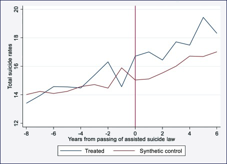
There is need for further research in this area but there is preliminary evidence published in peer review journals included several high quality studies and one systematic literature review. The evidence from these studies all points in the same direction. There is no evidence that legalisation of EAS would have a beneficial effect on suicide prevention. There is robust evidence, taken from different jurisdictions and using a variety of statistical methods, that the total number of self-initiated deaths rises significantly where EAS is legally available, and strong evidence that this has a greater impact on older women. There is some evidence, less robust but by some measures statistically significant, that deaths by non-assisted suicide also increase. There is no evidence of a reduction in non-assisted suicide.
This is not to deny that some people may find the presence of EAS makes them feel more secure, and less inclined to suicide but there will also be people who find its presence makes them feel less secure as if they have to justify their continued existence. Legalising EAS will affect different people differently but, in relation to suicide prevention, the evidence is that it does more harm than good.
The debate over the impact of EAS on suicide rates helps draw attention to the need for suicide prevention among older people and people who are chronically or terminally ill, especially those who are socially isolated. A key question is how to support people not only psychologically but practically and financially so they do not fear losing their independence. The knowledge that such support will be available is especially important during the period immediately after a terminal diagnosis. There is much that can be done but there is no evidence that changing the law on assisted suicide would help. On the contrary, there is increasing evidence that removing the legal prohibition on encouraging or assisting suicide could do significant harm. These are not only notional dangers but real dangers to people vulnerable to suicide. Legalisation of euthanasia or assisted suicide is a threat to suicide prevention.
If the issues discussed here affect you or someone close to you, you can call Samaritans on 116 123 (UK and ROI), visit their website https://www.samaritans.org/ or contact them on jo@samaritans.org.
If you are reporting or writing about a case of death by suicide, whether assisted or non-assisted, please consult media guidelines https://www.samaritans.org/about-samaritans/media-guidelines/ on how to do so responsibly.
[1] World Health Organization (WHO). (2014). Preventing suicide: A global imperative. Geneva: World Health Organization, p.2: https://www.who.int/publications/i/item/9789241564779
[2] Joseph M. Pierre (2015) ‘Culturally sanctioned suicide: Euthanasia, Seppuku, and Terrorist Martyrdom’. World Journal of Psychiatry, 5(1): 4–14. https://www.ncbi.nlm.nih.gov/pmc/articles/PMC4369548/
[3] ’10 top tips for reporting suicide’, Samaritans: https://www.samaritans.org/about-samaritans/media-guidelines/10-top-tips-reporting-suicide/
[4] World Health Organisation (WHO). (2017). Preventing suicide: A resource for media professionals, Updated 2017. Geneva: Department of Mental Health and Substance Use, World Health Organisation.
Niederkrotenthaler, Thomas, et al. ‘Role of media reports in completed and prevented suicide: Werther v. Papageno effects.’ The British Journal of Psychiatry 197.3 (2010): 234-243.
[5] For definitions see David Albert Jones (2021). ‘Defining the terms of the debate: Euthanasia and euphemism’, Briefing Papers: Euthanasia and Assisted Suicide. Oxford: Anscombe Bioethics Centre.
[6] See, for example, Ralph H. De Similien and Adamma Okorafor. ‘Suicide by Cop: A Psychiatric Phenomenon’. American Journal of Psychiatry Residents’ Journal. Volume 12. 1 (2017): 20-22 https://ajp.psychiatryonline.org/doi/pdf/10.1176/appi.ajp-rj.2017.120107
[7] Liam McArthur Assisted Dying for Terminally Ill Adults (Scotland) Bill: Consultation by Liam McArthur MSP, 22 September 2021, page 3, fn. 1.
[8] American Association of Suicidology (2017). ‘”Suicide” is not the same as “Physician aid in dying”’, Washington, DC: American Association of Suicidology.
[9] Geoff Bartlett, ‘Mother says doctor brought up assisted suicide option as sick daughter was within earshot’, CBC News, Jul 24, 2017: https://www.cbc.ca/news/canada/newfoundland-labrador/doctor-suggested-assisted-suicide-daughter-mother-elson-1.4218669
[10] For example, in 2019, of 5,631 ‘medically assisted deaths’ in Canada, only 7 were self-administered and of 2,655 euthanasia deaths officially reported in Belgium, in only 8 cases was the lethal dose taken orally.
[11] ‘In the present study the substantial increase in assisted suicide in older women… must be of concern’, see Nicole Steck, Marcel Zwahlen, and Matthias Egger (2015). ‘Time-trends in assisted and unassisted suicides completed with different methods: Swiss National Cohort’. Swiss Medical Weekly, 145, w14153. https://doi.org/10.4414/smw.2015.14153
[12] AAS (2017). ‘”Suicide” is not the same as “Physician aid in dying”’.
[13] Charlotte E. Allan, Vyara Valkanova, and Klaus P. Ebmeier. ‘Depression in older people is underdiagnosed’. The Practitioner 258.1771 (2014): 19-22. Hamish R. Sith ‘Depression in cancer patients: Pathogenesis, implications and treatment’, Oncology Letters 9.4 (2015): 1509-1514.
[14] These categories are taken from the Annual reports on the Oregon Death with Dignity Act. See Anscombe Bioethics Centre, Euthanasia and Assisted Suicide: A Guide to the Evidence, 5.3 Oregon: https://www.bioethics.org.uk/research/all-research-papers/euthanasia-and-assisted-suicide-a-guide-to-the-evidence/ See also, Phoebe Friesen, ‘Medically assisted dying and suicide: How are they different, and how are they similar?’, Hastings Center Report 50.1 (2020): 32-43: https://onlinelibrary.wiley.com/doi/pdfdirect/10.1002/hast.1083
[15] Tanya Neuner et al, ‘Assisted suicide on TV-the public “license to kill”?’, European Journal of Public Health, 19 (2009), 359–360: https://academic.oup.com/eurpub/article-pdf/19/4/359/1336336/ckp053.pdf David Albert Jones, ‘Assisted dying and suicide prevention’, Journal of Disability & Religion 22.3 (2018): 298-316. https://research.stmarys.ac.uk/id/eprint/2666/
[16] Richard Hurly, ‘Some groups of terminally ill patients are twice as likely to die by suicide, data show’, BMJ 2022; 377: o1014 doi: https://doi.org/10.1136/bmj.o1014 (Published 21 April 2022). See also David Albert Jones, ‘Legalising the encouragement and assistance of suicide will not help prevent suicide’, Rapid Response to the above: https://www.bmj.com/content/377/bmj.o1014/rr-7
[17] Jacky Davis, chair of Healthcare Professionals for Assisted Dying, quoted in Hurley, ‘Some groups of terminally ill patients are twice as likely to die by suicide’.
[18] Liam McArthur, Assisted Dying for Terminally Ill Adults (Scotland) Bill, page 11, fn. 35.
[19] Again, Jacky Davis in Hurley, ‘Some groups of terminally ill patients are twice as likely to die by suicide’, cites the death of her own brother as an example.
[20] In Oregon, since the law was passed in 1997, ‘a total of 3,280 people have received prescriptions under the DWDA and 2,159 people (66%) have died from ingesting the medications.’ Oregon Death with Dignity Act 2021, Data Summary, p. 5.
[21] Harmeet Nanner, ‘The effect of assisted dying on suicidality: a synthetic control analysis of population suicide rates in Belgium.’ J Public Health Policy 2021; 42(1): 86–97, p. 95.
[22] Dignitas. ‘Submission 67 by Dignitas to Medical Services (Dying with Dignity) Exposure Draft Bill 2014.’ Parliament of the Commonwealth of Australia.
https://www.aph.gov.au/DocumentStore.ashx?id=9d3ff5aa-2732-4402-ba87-3e7912088f1e&subId=299804
Emphasis added.
[23] EXIT. FAQ: ‘What Does Physician Assisted Suicide Mean?’, EXIT website. https://exit.ch/en/englisch/faq Emphasis added.
[24] David Albert Jones and David Paton, ‘How does legalization of physician-assisted suicide affect rates of suicide?, Southern Medical Journal, 108.10 (2015): 599-604
https://research.stmarys.ac.uk/id/eprint/3664/1/Suicide%20US%20SMJ%20as%20accepted.pdf
[25] Matthew P Lowe and Jocelyn Downie, (2017). ‘Does legalization of medical assistance in dying affect rates of non-assisted suicide?’, Journal of Ethics in Mental Health, Special Theme Issue II. Medical Assistance in Dying (MAID). https://jemh.ca/issues/v9/documents/JEMH%20final%20Legislation-iii.pdf
[26] Justine Dembo, Udo Schuklenk, and Jonathan Reggler. ‘“For their own good”: A response to popular arguments against permitting medical assistance in dying (MAID) where mental illness is the sole underlying condition’, The Canadian Journal of Psychiatry 63.7 (2018): 451-456, p. 453.
[27] Op. cit., Lowe and Downie, (2017), p. 7.
[28] David Albert Jones ‘Euthanasia, Assisted Suicide, and Suicide Rates in Europe’, Journal of Ethics in Mental Health 11 (2022):1-35 https://jemh.ca/issues/v9/documents/JEMH%20article%20EAS%20and%20suicide%20rates%20in%20Europe%20-%20copy-edited%20final.pdf
[29] OECD Suicide Data. (2021). Health status – Suicide rates. https://data.oecd.org/healthstat/suicide-rates.htm
[30] Federal Statistical Office. (2012). Cause of Death Statistics 2009: Assisted Suicide and Suicide in Switzerland. Neuchatel: Federal Statistical Office. https://www.bfs.admin.ch/bfs/en/home/statistics/catalogues-databases/publications.assetdetail.345104.html
[31] See Figure 4.
[32] Anne M. Doherty, Caitlyn J. Axe, and David A. Jones. ‘Investigating the relationship between euthanasia and/or assisted suicide and rates of non-assisted suicide: systematic review’, BJPsych open 8.4 (2022): https://www.cambridge.org/core/services/aop-cambridge-core/content/view/223FDD723EB5CAE84D2EF02C65A9F446/S2056472422000710a.pdf/investigating-the-relationship-between-euthanasia-andor-assisted-suicide-and-rates-of-non-assisted-suicide-systematic-review.pdf
[33] Doherty, Axe, and Jones. ‘Investigating the relationship between euthanasia and/or assisted suicide and rates of non-assisted suicide’, p. 7.
[34] Sourafel Girma and David Paton. ‘Is assisted suicide a substitute for unassisted suicide?’ European Economic Review 145 (2022): 104113. https://doi.org/10.1016/j.euroecorev.2022.104113
[35] Ibid., p. 8.
[36] Ibid., p. 9.
[37] Ibid., pp. 10-13.
Most recent
Disability and Assisted Suicide: Elucidating Some Key Concerns (Professor Tim Stainton)
28 August 2022
The Principle of Autonomy – Does it Support the Legalisation of Euthanasia and Assisted Suicide (Dr Xavier Symons)
08 April 2022
Euthanasia Case Studies from Belgium: Concerns About Legislation and Hope for Palliative Care (Professor Benoit Beuselinck)
13 December 2021
Support Us
The Anscombe Bioethics Centre is supported by the Catholic Church in England and Wales, Scotland, and Ireland, but has also always relied on donations from generous individuals, friends and benefactors.

